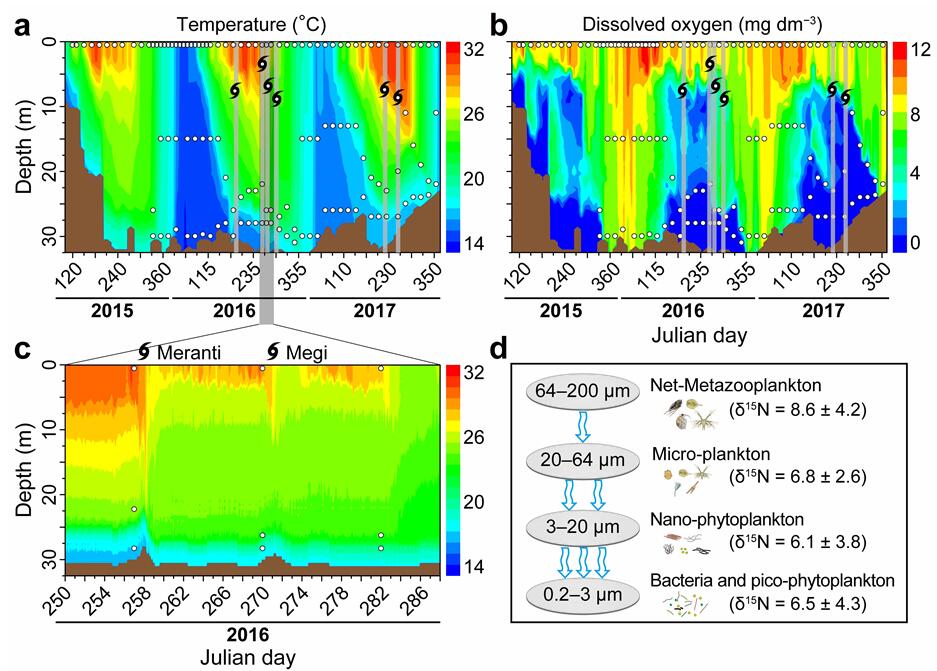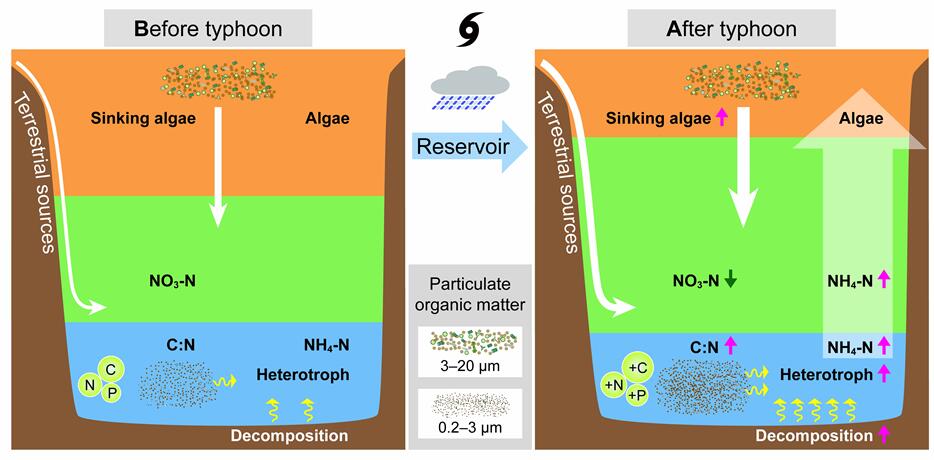In tropical and subtropical regions, the intensity of typhoon events (also termed tropical cyclones or hurricanes) are expected to increase as a consequence of the ongoing climate changes as well as to cause economic and ecosystem functioning losses due to the strong wind and torrential rain. Deep reservoirs and lakes are typically characterized by algae-rich surface waters (epilimnion) and potential nutrient-rich bottom waters (hypolimnion). Wind-induced mixing disturbances can bring the hypolimnetic nutrients up into the photic zone, and heavy precipitation may lead to an increase in the influx of terrestrial material, including nutrients, into these waterbodies. Such pulse disturbances are typically accompanied by an increased algae biomass or a shift in the plankton community composition. However, the underlying processes and mechanisms driving the variations of plankton community after typhoon are difficult to estimate from typical low-frequency monitoring. High-frequency observations using novel methodology, however, may enhance our understanding of the biogeochemical processes following episodic climatic disturbances in freshwater ecosystems in an increasingly changing world.

Figure 1 Environmental changes and the nitrogen stable isotope of particulate organic matter after typhoons.
The stoichiometry and stable isotopes of particulate organic matter (POM) are useful tools for the understanding of the biogeochemical processes associated with plankton dynamics and eutrophication processes. The stoichiometric variations of grazer and algae can influence the rates of nutrient release, altering the structure and functioning of freshwater ecosystems. Stable isotopes of POM have been widely used to study the biogeochemical processes and to track element sources. In fact, the size of POM is an important functional trait, as it affects the bioavailability and biogeochemical cycles of nutrients in aquatic ecosystems. The sizes of most free-living bacteria are typically < 3 μm, while most planktonic algae are larger and within the range 3–20 μm, and most protozoans and metazoan are > 20 μm and > 64 μm, respectively. The responses of plankton to typhoon-driven disturbances vary among size classes and along the water column. Previous study found that microbial communities exhibited a higher ability to recover from an artificial mixing disturbance in the surface waters than in the deep waters. Therefore, studies should not only focus on the microbial communities in the surface waters but also explore the potentially prolonged responses of the microbially mediated biogeochemical processes in the deep waters following strong winds (e.g., typhoons). However, the effects of typhoons on the biogeochemical processes mediating risk of eutrophication in deep freshwater ecosystems remain unclear.
A three-year study was conducted by Aquatic EcoHealth Group of the Institute of Urban Environment, Chinese Academy of Sciences to elucidate linkages among environmental change, stable isotopes and the stoichiometry of particulate organic matter (POM), and nutrient cycling (i.e., carbon, nitrogen and phosphorus) in a subtropical deep reservoir subjected to typhoon (tropical cyclone) events. We found that the typhoons significantly changed the nutrient levels in the deep waters as well as the thermocline position. Increased typhoon-driven organic matter input, algae sinking and heterotrophic decomposition interacted with each other to cause steep and prolonged increases of total nitrogen, ammonium nitrogen and total phosphorus in the bottom waters of the reservoir.
Small-sized or pico-sized POM (i.e., 0.2–3 μm) showed a substantial increase in bottom waters, and it exhibited stronger response than large-sized POM (i.e., 3–20, 20–64, 64–200 μm) to the typhoons. Our results also indicated that typhoons boosted the nutrient cycling in deep waters mainly through pico-sized POM. We found that the concentration and mass of POM were higher in the middle than bottom waters during the first 10 days after typhoons Meranti and Megi in 2016. Moreover, the concentration and mass of POM increased steeply immediately after the typhoons and then recovered to the pre-disturbance level again within the first month after the typhoons in the middle waters, concurrent with an accumulation and a prolonged increase in chlorophyll-a and the mass of POM in the bottom waters, indicating that the particle sinking was a key source of the organic matters in bottom waters already 3 days after the typhoons. Besides, our random forest regression and final partial least squares path models indicated that the algae (i.e., chlorophyll-a and Fv/Fm) played a key role in the particulate organic matter dynamics and nutrient cycling in the middle and bottom waters. Therefore, increased typhoon-driven organic matter input, algae sinking and heterotrophic decomposition interacted with each other to cause steep and prolonged increases of total nitrogen, ammonium nitrogen and total phosphorus in the bottom waters of the reservoir, and might increase the risk of eutrophication in deep reservoirs and downstream waters. Small-sized or pico-sized POM (i.e., 0.2–3 μm) showed a substantial increase in bottom waters, and it exhibited stronger and prolonged response than large-sized POM (i.e., 3–20, 20–64, 64–200 μm) to the typhoons. Further, the mass and stoichiometry of pico-POM were important indicators in the multi-nutrient cycling index for bottom waters, the δ15N correlated significantly with NH4-N, indicating that the typhoon-driven distinct nitrogen cycling processes contributed greatly to the increased NH4-N concentration. The typhoon-driven increase in the C:N ratio of pico-POM may reduce the energy transfer efficiency across trophic levels and accelerate the heterotrophic decomposition in deep waters. Our results indicated that typhoons boosted the nutrient cycling in deep waters mainly through pico-sized POM. Therefore, the increased typhoon-driven organic matter input and nutrient cycling in the bottom waters potentially increase the risk of eutrophication and harmful algal blooms of deep reservoirs.

Figure 2 Graphical abstract
This study evaluated the ecological consequences of typhoon events by combining stable isotope and stoichiometry analyses with a multi-nutrient cycling index in a subtropical deep reservoir. We found a more prolonged response of nutrients and POM in the bottom than in the surface and middle waters following typhoon events. The pico-POM was a key contributor to the enhanced nutrient cycling in deep waters. Therefore, in future study, the longer-term high-resolution sampling of different POM size fractions and water layers should be considered to gain a better understanding of the effect of typhoons on deep water ecosystems.
The abovementioned findings have recently published in Water Research named “Particulate organic matter as causative factor to eutrophication of subtropical deep freshwater: Role of typhoon (tropical cyclone) in the nutrient cycling”. This work was funded by the National Natural Science Foundation of China (91851104, 31672312 and 41703074) and the Natural Science Foundation of Fujian Province of China (2019J02016).